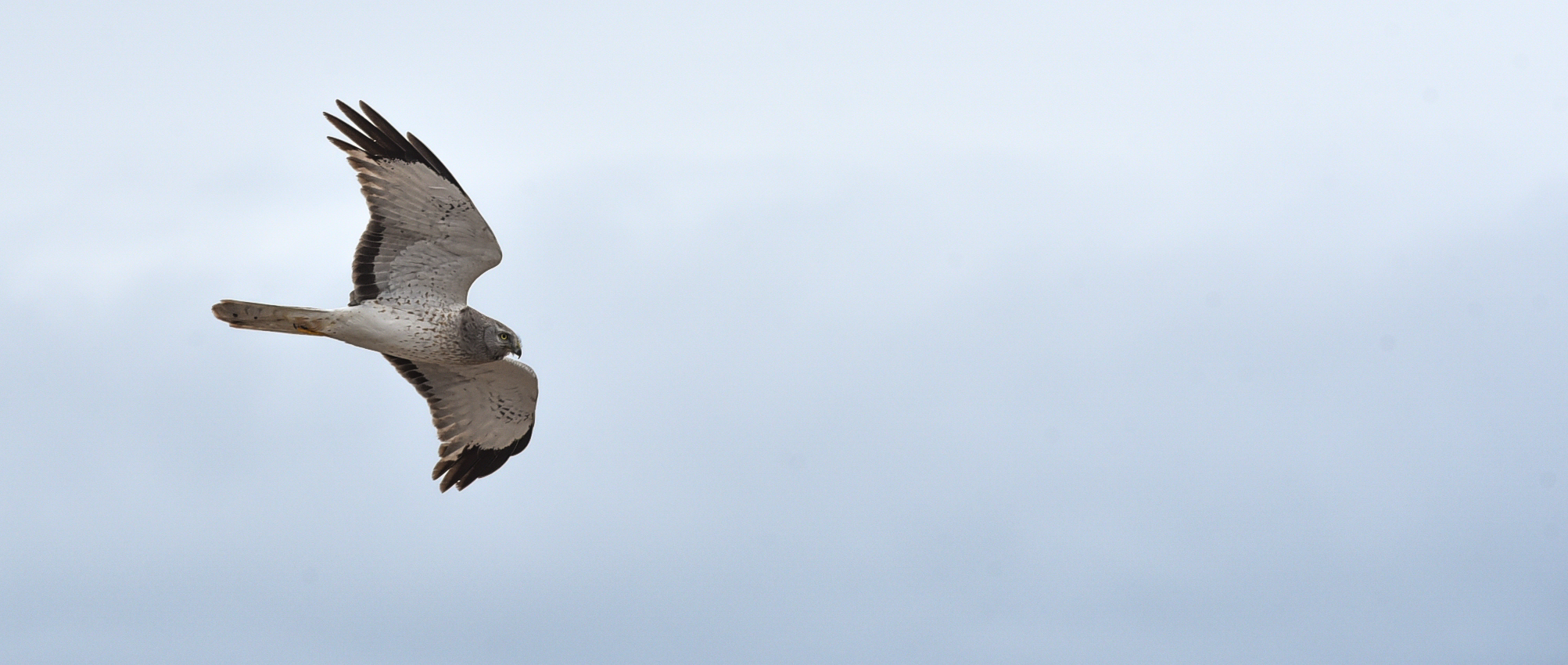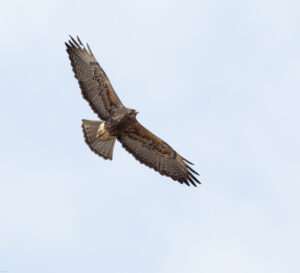 On the morning of Tuesday, March 15, I strapped on my snowshoes and made my way out and up to the top of the dune where the Whitefish Point Bird Observatory (WPBO) hawk deck stands. The boardwalk that starts just past the Great Lakes Shipwreck Museum was buried in snow 2–3 feet deep, and the drifts had completely covered the 47 steps that led up to the platform. The last few were blocked by a mountain of a snowdrift that was too steep to walk over with the snowshoes. So, off the shoes came, and I climbed over the mound with the ambition of a child that is allowed to go outside and play on a snow day. It felt appropriate that I had to claw my way onto the hawk deck to achieve access to what would be my home away from home and serve as my humble office for the next two and a half months — the raptor counter shack.
On the morning of Tuesday, March 15, I strapped on my snowshoes and made my way out and up to the top of the dune where the Whitefish Point Bird Observatory (WPBO) hawk deck stands. The boardwalk that starts just past the Great Lakes Shipwreck Museum was buried in snow 2–3 feet deep, and the drifts had completely covered the 47 steps that led up to the platform. The last few were blocked by a mountain of a snowdrift that was too steep to walk over with the snowshoes. So, off the shoes came, and I climbed over the mound with the ambition of a child that is allowed to go outside and play on a snow day. It felt appropriate that I had to claw my way onto the hawk deck to achieve access to what would be my home away from home and serve as my humble office for the next two and a half months — the raptor counter shack.
The first day of the season is always filled with anticipation. What will be the first raptor of the season? How will the season play out? Which species will I see more or less of? Will I freeze to death? I am sure these questions are common to migration counters everywhere, though the last may be more Whitefish Point specific. All of these questions became much more sobering after my snowy jaunt and the reality that winter was far from over set in.
It is said that March comes in like a lion and goes out like a lamb — only this year, the lion decided to eat the lamb and stick around until it ate all the lambs in the U.P. Freezing cold, biting north winds, dense foggy days, and wet weather kept raptors away from the Point. Only 70 raptors, in total, were counted during the 116 hours spent observing from the confines of my shack in March. In 17 days, only two days saw double-digit numbers, with the highest daily total being 24 raptors thanks to 17 Bald Eagles that took advantage of the best weather day of the month. Of the other days, 10 of those days saw three raptors or less, and there were even three days where raptors were nowhere to be seen at all. It was a tough start to the season, and the oppressive gray skies, my numb extremities, and lack of birds made for long days of nothing but imagining raptors somewhere far south of me still waiting for their chance to move.
Starting with a three-day streak of zero raptors, the first half of April could do nothing to satiate the March Lion’s appetite as I watched it go on to devour the Easter Rabbit. The bad weather was keeping migrating birds either stalled or forcing them to take alternative routes as the numbers remained at a historic low. In fact, by mid-April, I was beginning to worry if I was bearing witness to the all-time worst raptor migration in the 44 years of the WPBO raptor count. More than anything, the first half of the 2022 spring season proved to me that the biggest factor affecting migration count numbers is the weather. On April 20, a southwesterly wind brought my first triple-digit flight of the season in the form of 121 Sharp-shinned Hawks. Following those west winds, the wind turned southerly, and on April 22, they brought a unique visitor in the form of a Swainson’s Hawk, a rare western visitor from the Great Plains. Finally, on April 24, a strong south wind brought season-high counts of American Kestrel (205), Northern Harrier (91), and Rough-legged Hawk (39) along with 676 Sharp-shinned Hawks. With a total of 1,076 raptors counted, April 24 was the day the March Lion decided it had its fill, left for good, and all those birds I had imagined sitting around twiddling their talons back in March had finally decided it was time to go! The last week and a half of April saw 4,359 raptors fly over the Point, with the last day of the month bringing the second Swainson’s Hawk of the season. With such a great end to the month, I was cautiously optimistic that migration had gotten back on track and hopeful as I used my last set of hand and toe warmers that I wouldn’t need anymore.
May did not disappoint as it made me all but forget about the harsh trials of the beginning of the season. With more raptors in the sky than I had seen in my previous seasons at Whitefish Point, I enjoyed counting more than ever before. The first week brought over 4,000 Broad-winged Hawks with a single-day high count of 1,812 and the following week brought over 4,000 Sharp-shinned Hawks with a single-day high count of 1,443. During the first half of the month, there were days when raptors surrounded me, and some days it was hard to tear myself away from the deck at the thought of missing what might come next. The Swainson’s Hawk guest appearances continued, and the individual that was seen on the last day of April was seen again on consecutive days and then a third for the season arrived on May 12. With 13,524 raptors, the month of May accounted for 74% of the entire season’s flight; that’s a mid-season turn-around that any baseball team would be jealous of! Still, the weather remained cool throughout the month, and by the end of the third week, northerly winds began to dominate again.
For the last week and a half, the feeling of migration’s end was palpable in the air, and the dwindling number of raptors in the sky attested to this. It seemed like the season’s count would end with nothing more than a sigh, but the last two days saw some southwesterly winds, and a final push of immature Bald Eagles kept the counter clicking. On the afternoon of the very last day of the count, as I was aging a first-year Bald Eagle, another bird drew my attention away from it. I gasped audibly at the moment I realized I was looking at a Mississippi Kite! What a spectacular way to end a season that initially I thought would go down in the record books as the worst of all. I have seldom had a bird bring me such elation as this kite, and that feeling alone made every minute of the whole season worth it.
After the dust has settled, I look back at the spring of 2022. Boiling it down to the numbers, over 78 days and 575 hours of counting, a total of 18,386 individual raptors were recorded across 17 species. The total number of raptors counted was 5% above the all-time average total. No new high or low counts were recorded. Distinct species tallied at 17, with their relative abundance varying greatly, ranging from 10 Cooper’s Hawks to 8,078 Sharp-shinned Hawks. Sharp-shinned Hawk accounted for 43.9% of all raptors recorded, with Broad-winged Hawk making up another 37.6% of the total. This season’s data compared with the past 44 years supports evidence that several raptors such as Turkey Vulture, Bald Eagle, Golden Eagle, Merlin, and Peregrine Falcon have increased relative abundance, while others such as Red-tailed Hawk, Cooper’s Hawk, and Rough-legged Hawk exhibit declines.
All that being said, no numbers compare to the experience of spending a season counting at Whitefish Point. Beyond the birds and the weather are all the wonderful people who come to share the experience and create a community of appreciation for all things with wings, for which I am grateful.
~ by Richard Couse, WPBO Spring Raptor Counter
Featured photo: Northern Harrier by Alison Világ

Rich is a conservation biologist from Massachusetts. He is a firm believer in the fact that everything is connected through the ecological web of life, and his path reflects his fascination with all creatures great and small. His field research has taken him to Massachusetts, Michigan, Maine, and beyond.
This section of the Jack Pine Warbler is dedicated to Michigan Audubon’s Whitefish Point Bird Observatory and features three articles illuminating the research conducted at WPBO this spring. This work focused on waterbirds (April 15–May 31), raptors (March 15–May 31), and owls (March 15–May 31).
As one of the three pillars of Michigan Audubon’s mission, research is at the heart and soul of what we do and integral to our value proposition. Whitefish Point ranks among North America’s most significant avian migration sites, and the observatory’s long-term research programs provide a picture of species dispersion, populations, demographics, movement, and more. This research is made possible through donations to Michigan Audubon that support our efforts to engage highly talented individuals to perform this work.
WPBO is located just north of Paradise, Michigan, along the shore of Lake Superior. The outdoor spaces of WPBO are open daily from dawn to dusk year-round. You can learn more at www.wpbo.org.


